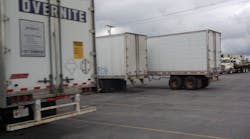Despite slight month-to-month slippage in orders, overall demand for trailers remains very strong heading into the second half of 2014 – with the need to both replace aging units and add capacity expected to keep trailer orders brisk.
ACT Research Co. noted that while June net trailer orders dropped from May about 1% to 22,000 units, they remain 42% higher compared to the same month in 2013. The firm added that year-to-date total net trailer orders of 156,000 units are up 45% over the same period last year.
“Strength in June came from specialty trailers, with platforms posting a 42% month-to-month gain while liquid and bulk tanks both surged over 75% from May levels,” noted Frank Maly, ACT’s director of CV transportation analysis and research.
He added that trailer inventory increased 6% month-over-month as well, as tight trucking capacity continues to interfere with pick-up of new equipment, although he added that some progress is expected in upcoming months.
Rodney Ehrlich, senior VP and chief technology officer for Wabash National Trailers, noted that one reason behind the uptick in trailer orders is that fleets are realizing that they can gain greater efficiencies by replacing older trailers with new units – especially when it comes to dry van models.
“For new 53-ft. dry van models, compared to 10 years ago, they are 600 to 700 lbs. lighter on average – and in some cases 1,500 lbs. lighter due to new designs,” he explained to Fleet Owner. “Today, most of the dry van market has shifted away from heavier sheet-and-post designs to composite models, which is also allowing fleets to extend life cycles from 8 to 10 years out to 13, 14, and event 15 years.”
Michael Baudendistel, VP with Wall Street investment firm Stifel, Nicolaus & Co., noted in a research brief that usually the summer months are often “least favorite time of the year” for truck and trailer OEMs as slowing orders and increased production rates create tension associated with declining cushion in backlogs.
“However, orders this summer have held up well so far, which we attribute largely to carriers chasing fuel economy enhancements associated with new equipment,” he said. “Trucking equipment production has been ramped up to above replacement levels, which should lower the average age of the equipment in the field.”
In fact, so far this summer, Baudendistel said net trailer orders have held up better than what is typical. “In a normal year, net orders will typically decline 25% to 35% from April to May,” he explained. “This year, net orders declined 11% from April to May followed by the relatively modest decline of 6% from May to June.”
Stifel also noted that the year-over-year increase in trailer production is very broad across most model types with dry vans, refrigerated vans, platforms, and tank trailer builds up 27%, 4%, 10%, and 18%, respectively. For the first half of 2014 overall, 7% more trailers were built relative to the first half of 2013.
The firm added that the trailer production “backlog” at the end of June totaled 134,935 units across all model types, which is up 45% year-over-year and up 2.3% from 131,867 units at the end of the first quarter.
That represents about five months of production at the ramped up June build rates, Baudendistel pointed out, and five months of production backlog is within what he characterized as well within the industry’s “comfort range” of four to six months.
On top of that, year-to-date gross trailer order cancellations only totaled 2.8%, which indicates to Stifel’s analysts that the nearly 135,000 trailer production “backlog” is made up of firm orders.
Wabash’s Ehrlich added that one of the things fleets need to understand is that OEMs have actually removed many maintenance items from trailer designs over the last decade – not just reducing maintenance costs, but eliminating entire maintenance requirements altogether. “That really changes the cost of ownership footprint for trailer owners when looking at whether to buy new units or refurbish older ones,” he stressed.
Rob Fortney, dealer sales director for Great Dane Trailers, echoed that view. “New trailers include the latest in technology in terms of lighter weight structures and components, aerodynamic enhancements, cargo restraint and corrosion resistance,” he explained to Fleet Owner. “They are less likely to need repairs than used trailers, which typically take the trailer out of productive service. Plus they are prettier and have that new trailer smell. You can’t beat that combination.”



